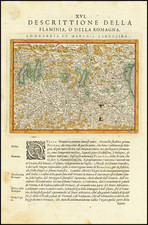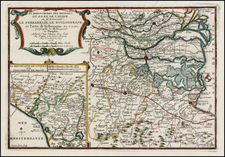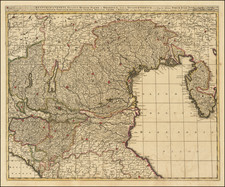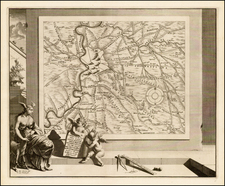Finely executed early 18th Century map of the Duchy of Milan and its environs, providing an intricate view of the region's geography and a historical snapshot of a time of great political change.
The map prominently features major cities including Milan, Genova, Mantova, Modena, Verona, Trient, Cremona, Parma, Piacenza, and Pavia. These cities were centers of political, economic, cultural, and military significance. Major water bodies such as Lago Maggiore, Lago Como, and Lago Garda, as well as vital rivers like the Po, Adda, and Ticino, highlight the region's natural beauty and their importance in trade and agriculture.
The geopolitical history of the Duchy of Milan during the early 18th Century was marked by complexity and contestation. Initially under Spanish rule, the War of Spanish Succession led to a shift in control to the Austrian Habsburgs after the Treaty of Utrecht in 1713. Throughout the first half of the 18th Century, the region remained a battleground for European powers.
The map is not just a geographical representation but a historical document reflecting the cultural richness, natural beauty, and political turmoil of the region. It captures a time when the map of Europe was being redrawn, and regional identities were shaped by wars, treaties, and the ambitions of ruling powers, providing an enduring insight into the intertwined nature of geography and history.
Johann Baptist Homann (1663-1724) was a mapmaker who founded the famous Homann Heirs publishing company. He lived his entire life in Bavaria, particularly in Nuremberg. Initially, Johann trained to become a priest before converting to Protestantism and working as a notary.
In 1702, Johann founded a publishing house that specialized in engravings. The firm flourished, becoming the leading map publisher in Germany and an important entity in the European map market. In 1715, Johann was named Imperial Geographer to the Holy Roman Empire by Charles VI and made a member of the Prussian Academy of Sciences. Most importantly for his business, his reputation and contacts gained him imperial printing privileges which protected his publications and recommended him to customers. Johann is best known for this Grosser Atlas ueber die ganze Welt, or the Grand Atlas of the World, published in 1716.
After Johann died in 1724, the business passed to his son, Christoph (1703-1730). Upon Christoph’s early death, the company passed to subsequent heirs, with the name of the company changing to Homann Erben, or Homann Heirs. The firm continued in business until 1848.









![Rhetiae alpestris descriptio in qua hodie Tirolis Comitatus [with] Goritiae, Karstii, Chaczeolae, Carniolae, Histriae, et Windorum Marchae Descrip.](https://storage.googleapis.com/raremaps/img/small/83989.jpg)



![[Savona Province and Environs]](https://storage.googleapis.com/raremaps/img/small/65400.jpg)
